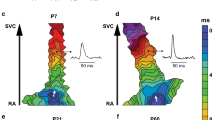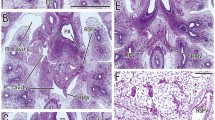Abstract
Development of cardiac musculature in the rat cranial vena cava (common cardinal vein or duct of Cuvier) was examined by immunohistochemistry and transmission electron microscopy. Undifferentiated cardiac myocytes were detected in the cranial vena cava wall of rat embryos after 12.5 days post-coitum (dpc). The tunica media of the cranial vena cava was composed of cardiac myocytes after formation of the endothelium. Therefore, the cranial vena cava may be not only a part of the venous system but also of the heart. Myocytes in the cranial vena cava contained developing myofibrils, mitochondria and intercalated discs similar to those found in the myocytes in the heart. Striated myofibrils began to differentiate as soon as myocytes appeared in the vena cava wall, and myocytes with differentiating myofibrils occur in the wall as the first component of the tunica media at 12.5 dpc. We concluded that the cardiac musculature in the vena cava is not a secondary extension into the tunica media after birth only in the rat, but a basic structure formed in all mammals during early embryonic development.
Similar content being viewed by others
References
Asai J, Nakazato H, Toshimori H, Matsukura S, Kangawa K, Matsuo H (1987) Presence of atrial natriuretic polypeptide in the pulmonary vein and vena cava. Biochem Biophys Res Commun 146:1465–1470
Ayettey AS, Navaratnam V (1978) The T-tubule system in the specialized and general myocardium of the rat. J Anat 127:125–140
Bogush G (1979) Electron microscopic investigations on the differentiation of Purkinje cells in the ontogenic development of the chicken heart. Anat Embryo 155:259–271
Carrow R, Calhoun ML (1964) The extent of cardiac muscle in the great veins of dog. Anat Rec 150:249–256
Cheng Y (1971) The ultrastructure of the rat sino-atrial node. Acta Anat Nippon 46:339–358
Danilo PJ, Reder RF, Binah O, Legato MJ (1984) Fetal canine cardiac Purkinje fibers: electrophysiology and ultrastructure. Am J Physiol 246:H250-H260
Endo H, Mifune H, Kurohmaru M, Hayashi Y (1994) Cardiac musculature of the cranial vena cava in the rat. Acta Anat 151:107–111
Endo H, Maeda S, Kimura J, Yamada J, Rerkamnuaychoke W, Chungsamarnyart N, Tanigawa M, Kurohmaru M, Hayashi Y, Nishida T (1995) Cardiac musculature of the cranial vena cava in the common tree shrew (Tupaia glis). J Anat 187:347–352
Forsgren S, Thornell LE (1981) The development of Purkinje fibers and ordinary myocytes in the bovine fetal heart. Anat Embryol 162:127–136
Lin JJC, Chou CS, Lin JLC (1985) Monoclonal antibodies against chicken tropomyosin isoforms: production, characterization and application. Hybridoma 4:223–242
Masani F (1986) Node-like cells in the myocardial layer of the pulmonary vein of rat; an ultrastructure study. J Anat 145:133–142
Melax H, Leeson TS (1970) Fine structure of the impulse-conducting system in rat heart. Can J Zool 48:837–839
Mochet M, Moravec J, Guillemot H, Halt PY (1975) The ultrastructure of rat conducting tissue; an electron microscopic study of the atrioventricular node and the bundle of His. J Mol Cell Cardiol 7:879–889
Nathan H, Gloobe H (1970) Myocardial atrio-venous junctions and extensions (sleeves) over the pulmonary and caval veins. Anatomical observations in various mammals. Thorax 25:317–324
Navaratnam V (1987) Differentiation of the myocardial rudiment in mouse embryos. In: Navaratnam V (ed) Heart muscle: ultrastructural studies. Cambridge University Press, Cambridge, pp 1–29
Navaratnam V, Kaufman MH; Skepper JN, Barton S, Guttridge KM (1986) Differentiation of the myocardial rudiment in mouse embryos: an ultrastructural study including freeze fracture replication. J Anat 146:65–85
Reynolds ES (1963) The use of lead citrate at high pH as an electron-opaque stain in electron microscopy. J Cell Biol 17:208–212
Toshimori H, Nakazato M, Toshimori K, Asai J, Matsukura S, Oura C, Matsuo H (1988) Distribution of atrial natriuretic polypeptide (ANP)-containing cells in the rat heart and pulmonary vein. Cell Tissue Res 251:541–546
Van der Loop FTL, Schaart G, Langmann W, Ramaekers FCS, Viebahn CH (1992) Expression and organization of muscle specific proteins during the early developmental stage of the rabbit heart. Anat Embryol 185:439–450
Viragh S, Challice CE (1973) Origin and differentiation of cardiac muscle cells in the mouse. J Ultrastruct Res 42:1–24
Watson ML (1958) Staining of tissue sections for electron microscopy with heavy metals. J Biophys Biochem Cytol 4:727–729
Author information
Authors and Affiliations
Rights and permissions
About this article
Cite this article
Endo, H., Ogawa, K., Kurohmaru, M. et al. Development of cardiac musculature in the cranial vena cava of rat embryos. Anat Embryol 193, 501–504 (1996). https://doi.org/10.1007/BF00185881
Accepted:
Issue Date:
DOI: https://doi.org/10.1007/BF00185881




